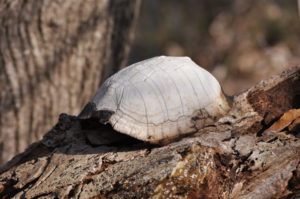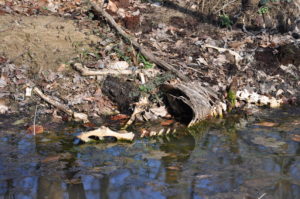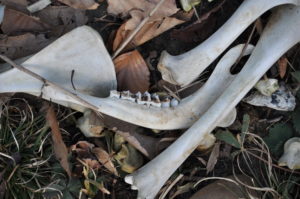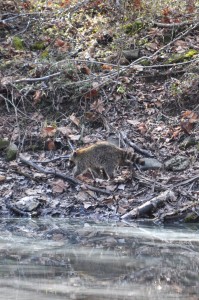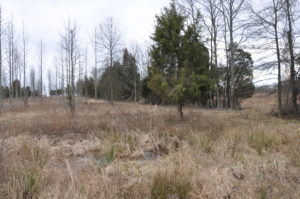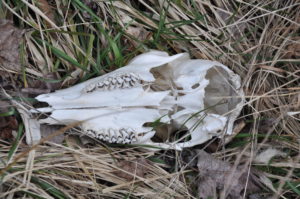There is nothing that speaks to the collision of Suburbia and Nature like an encounter with the skeletal remains of deer inside the city limits.
March came in like a lamb and the soft air lures us out to wander through patches of sunshine by creek and through woods and fields. Sometimes we find beautiful rocks or other fascinating objects for our increasingly crowded mantelpiece. That almost-vernal afternoon we headed to Mullins Park on the east edge of the city to check out the turtle pond, sort of a slime-ridden puddle where they like to bask in the afternoon light.
It is a place well known to my Dear One. As a lad he worked for Mr. Mullins, driving a salvage truck to and from Baltimore and keeping the junkyard’s books; then there were those nocturnal raccoon hunts. The park, all 239-plus acres of it, was a farm for decades and later a landfill. Now it is a swampy open area surrounded by woods and ravines bordered by creeks and marshes.
During our pursuit of the sub-order Cryptodira, we detoured down a slope to the edge of Swan Creek, whose winding course forms one boundary of the park. Swan Creek also divides erstwhile wilderness from human habitation; a large trailer park occupies the opposite hillside. Near the bottom of the path, at the edge of the water, lie the remains of a deer. The skeleton is largely complete; the absence of antlers suggests that the creature was a doe or that the deer was killed out of season. Furry hide still clung in patches, along the forelegs and on the ribcage.
Had it fallen victim to some disease? Had it been killed by a blast from across the creek? Had it been hunted and wounded elsewhere and made it this far only to succumb to its injuries?
A little downstream deep water made further progress impossible without hip waders, so we retraced our steps and continued down the track that leads to the turtle pond. Just off the track we came across another pile of bones, deer mandibles and what is probably a raccoon skull. The pile with its neat heap of leg bones was clearly the work of human hands.
There was a movement perhaps twenty yards down the trail. We both looked, we both glimpsed a creature so dark it looked black, its plume of a tail quite visible. A bear? We have black bears but they don’t have tails. It was not a dog and was far too large to be a cat. A unique and mysterious creature, Mullins Park’s own version of Big Foot, a Yeti, or the Loch Ness Monster?
We continued on our way. My Dear One saw the only two turtles in evidence. I saw the ripples they left behind them as they dived for cover. Then I saw something else. A raccoon meandered down the opposite shore, clambering across fallen trees, pausing to investigate a burrow hole. Unlike the turtles, he seemed unperturbed by our approach, and we watched him for two or three minutes until he disappeared into the undergrowth.
A day or two later we a different direction, to a tract of land that separates a residential neighborhood from the adjacent shopping center. It lies in the northwest corner where the city boundaries cross Interstate-95 to encircle Ripken Stadium. A few years ago someone had gone in and clearcut the trees, mostly black gums and a few scrubby cedars, leaving it an open brushy field. Its apparent flatness turned out to be an illusion: from the other side, the area resembles a bowl with the road at its rim. As we followed the deep ruts left by some tractor or industrial-weight vehicle, the ground went from damp to swampy to a morass of vernal pools. From the trees to the right came a guttural call from some bird we don’t think we have ever encountered. Soon the faint peeping of frogs in lust crescendoed into riotous chorus—and decrescendoed to pianissimo and then silence as we reached the edge of their puddle.
It is a forsaken area, thirty-four acres of apparently ignored property transferred from the Stancills to the city in 2001 for the princely sum of $0.00. The constant roar of highway traffic is unpleasant but not intolerable. Creeks and run-off cut through the woods—tributaries of Carsins Run, perhaps, waterways that look as though they might connect with Swan Creek—and splash against boulders.
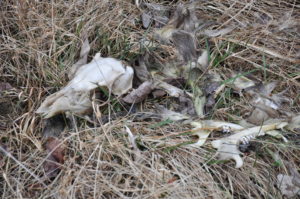 We followed a series of squat, conical concrete obtrusions, caps for the sewer line that runs from the Stadium back to the pumping station and from thence to the sewage plant. Trash littered the woods on either side and crude shelters suggested that the woods were regularly home to the homeless. A deer skeleton lay off to one side. We looked at it and walked on.
We followed a series of squat, conical concrete obtrusions, caps for the sewer line that runs from the Stadium back to the pumping station and from thence to the sewage plant. Trash littered the woods on either side and crude shelters suggested that the woods were regularly home to the homeless. A deer skeleton lay off to one side. We looked at it and walked on.
The track ended in a sort of cul-de-sac from which we could see cars speeding by on I-95. Someone had constructed a tree stand on the perimeter. A sturdy wood ladder reached to a platform ten or twelve feet above the ground; an overturned white plastic bucket provided a seat. Here we found perhaps four discrete piles of deer remains. We looked at each other and eyed the trajectory between the tree stand and the highway: someone was firing a gun in the general direction of the traffic.
We do not weep for these dead deer. There are far too many deer and far too little habitat, even when you count our property with its flowers and shrubs as habitat. The number of whitetail deer had declined to about 500,000 in the early 1900s and now is estimated at about 15 million. We toss out dried corn and bruised apples for our local herd and look forward to that moment that the does allow their fawns to leave the camouflaged safety of the woods and frolic in the open.
As I have been known to say, I will not shoot Bambi myself, but I know that hunting is essential if the population is to be kept at all under control, if woods are to be saved from their depredations, if their contributions to deforestation is to be kept from damaging the watersheds and destroying habitat for all the critters out there.
Venison is, moreover, a perfectly tasty protein, and animals culled by private and government sharpshooters could stock countless pantries.
We were delighted when that piece of the old Mullins property became a park, a natural reserve. We hope that the land once owned by a Stancill could be transformed into a playground-cum-conservation area, with walking and biking trails, a playground, a few picnic tables and perhaps a basketball court, making it a facility the city sorely needs.
The remains of the deer, if nothing else, remind us that terrestrial space is not infinite and that for our own good, our own safety and a future boasting anything resembling a decent quality of life, we have to learn to share

